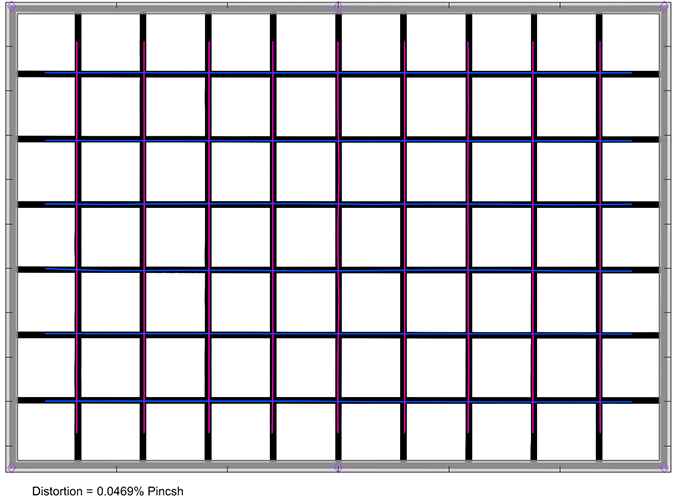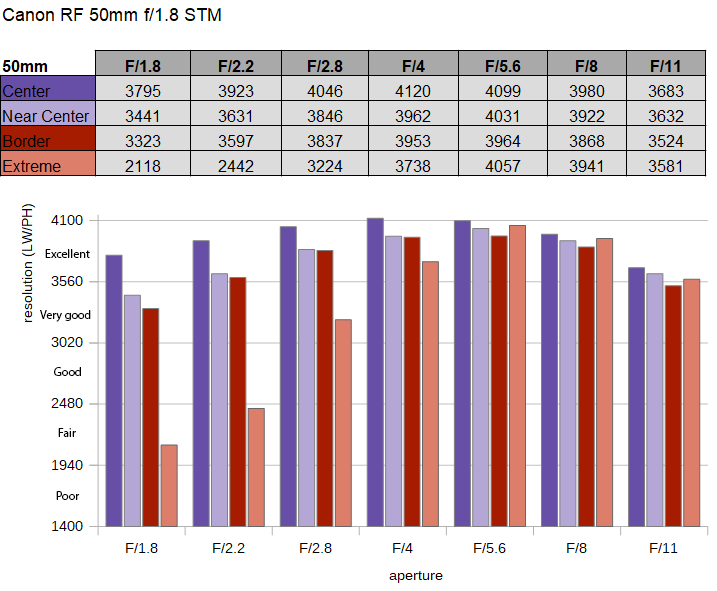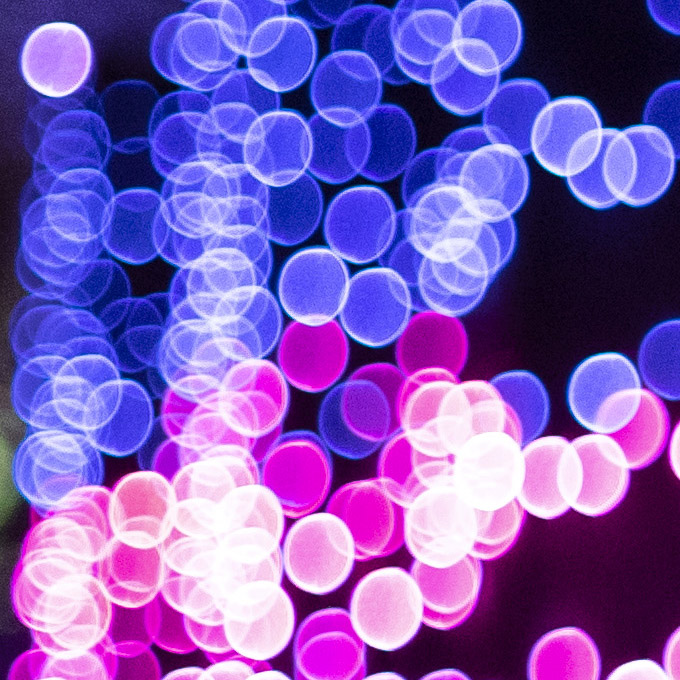|
Canon RF 50mm f/1.8 STM - Review / Test Report - Analysis |
|
Lens Reviews -
Canon EOS (Full Format)
|
|
Page 2 of 3

Distortion
The Canon RF 50mm f/1.8 STM produces a negligible amount of distortions so there isn't really any additional benefit/drawback with activated auto-correction.

Vignetting
A weakness of the lens is certainly the amount of vignetting at large-aperture settings - at least in RAW files. The vignetting at f/1.8 exceeds our usual scale for full-format lenses with a whopping ~3.6EV (f-stops) and it's still very high at f/2.2. You have to stop down to f/4 for a reasonable suppression of the issue.
Correspondingly, auto-correction has to be rather aggressive with this lens. It reduces the vignetting by 2 stops at f/1.8 - with a similar increase of corner (sensor-)noise due to the required signal boosting. The vignetting is well-controlled from f/2.8 in this case.

MTF (resolution) at 45 megapixels (EOS R5)
The resolution characteristic of the RF 50mm f/1.8 STM is decent overall but also a little wild in places. It is impressive that the lens is capable of maintaining a very high resolution from the center to the borders at f/1.8 - but the corner quality falls apart including a sharp drop in contrast. The corner softness barely improves at f/2.2 but reaches good levels at f/2.8. Truly excellent quality across the image frame is reached between f/4 and f/8. f/11 sees some diffraction effects but the results are still very good. f/16 and beyond (not shown) should be generally avoided as usual.
The centering quality of the tested sample was Ok. The field curvature is low.
Please note that the MTF results are not directly comparable across the different systems!
Below is a simplified summary of the formal findings. The chart shows line widths per picture height (LW/PH) which can be taken as a measure of sharpness.
If you want to know more about the MTF50 figures, you may check out the corresponding Imatest Explanations

MTF (resolution) at 30 megapixels (EOS R)
Not everybody has an expensive EOS R5 so some of our readers are surely interested in how the lens performs on a more sanely priced camera - and it's good to have a comparison with the existing set of 30mp-based reviews anyway.
As you can see below, the general theme remains pretty much the same - albeit on a different numeric scale. Due to the lower megapixel count, you can expect that the sharpness perception is slightly better on pixel level. However, the corner weakness at large apertures remains.
Please note, that we apply a MILD amount of sharpening during the RAW conversion and sharpening is more receptive to cleaner edges on lower megapixel images so, besides other reasons, the numbers obtained with the EOS R are NOT comparable to the R5 variant.

Chromatic Aberrations (CAs)
There are traces of lateral CAs visible at f/1.8 with an average pixel width of ~0.7px at the image borders. Stopping down reduces the issue and it's is negligible from f/4. Lateral CAs can be corrected without any loss in image quality so it's not an overly important aspect anymore.

Bokeh
The Canon RF 50mm f/1.8 STM struggles with the quality of the out-of-focus rendering although this doesn't apply to all aspects.
Let's start with something positive. The image below illustrates the out-of-focus highlights in the image center. As you can see the discs are nicely rendered with a smooth inner zone and no noticeable outlining. The circular shape remains intact even at f/2.8.
 Now that being said - this applies to the image center only. Below is an example showing the highlights towards the borders - and they are showing a very distinctive "bubble-like" outlining. In order to avoid this, you should stop down a little bit in such situations - unless you like bubbles, of course. Some do.
Now that being said - this applies to the image center only. Below is an example showing the highlights towards the borders - and they are showing a very distinctive "bubble-like" outlining. In order to avoid this, you should stop down a little bit in such situations - unless you like bubbles, of course. Some do.
 As so often the circular disc shape deteriorates to cat eyes depending on the location within the image field. At f/1.8, the circular shape is only maintained within a narrow zone around the center. This zone broadens substantially at f/2.2 and more so at f/2.8.
As far as the general blur is concerned, we aren't fans really. The foreground blur (shown to the left) is very "smeary". The background blur (to the right) is better. However, once again - this applies to the very center. The situation is worse beyond - see also the next chapter.
As so often the circular disc shape deteriorates to cat eyes depending on the location within the image field. At f/1.8, the circular shape is only maintained within a narrow zone around the center. This zone broadens substantially at f/2.2 and more so at f/2.8.
As far as the general blur is concerned, we aren't fans really. The foreground blur (shown to the left) is very "smeary". The background blur (to the right) is better. However, once again - this applies to the very center. The situation is worse beyond - see also the next chapter.

Bokeh Fringing
Normally our LoCA test scene is just meant for illustrating color fringing on the Z-axis. However, in this case, it is showing a little bit more than that. The first thing that you may notice is the incredible softness and washed-out edges. As mentioned above the performance of the lens falls apart at close focus distances - and this test is executed at fairly close distances. If the lens didn't show a very decent quality at conventional focus distances, we'd consider it to be defective really (note: it uses a simple linear extension system so there's no sophisticated magic going on during focusing. The whole optical system is shifted back and forth for focusing).
As far as the bokeh fringing is concerned - yes, there is some at f/1.8 with a greenish tint in the background and purplish in the foreground. Stopping down to f/2.2 reduces the issue and it's not too bad anymore at f/2.8.
|